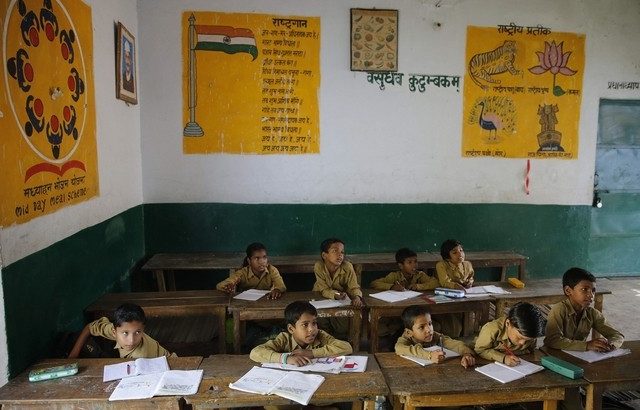Asia/India/Septiembre de 2016/Autora: Rebecca Bundhun/Fuente: The National
RESUMEN: En la escuela Malleswaram en Bangalore, que consiste en un par de aulas básicas, un grupo de niños de 8 años de edad, sentados en el suelo, practican su escritura en kannada, el idioma local. Su maestro no habla Inglés. Ellos no tienen escritorios. A la hora del almuerzo, se sientan en el suelo para comer su almuerzo. La escuela dirigida por el gobierno es gratis. Lejos de la ciudad, en el campo de Belgaluru, la escena no podía ser más diferente en la Escuela Internacional de Stonehill, una escuela privada sin ánimo de lucro, creada por uno de los principales promotores de Bangalore, Embajada de grupo. Allí, los niños de la India y de expatriados privilegiados disfrutan de modernas aulas donde se imparten en Inglés y tienen los beneficios de una amplia cafetería, una piscina y amplios campos de juego repartidas en 34 acres. Las tasas varían de US $ 9,400 a más de $ 26,000 al año. Estos son los dos extremos del sistema educativo de la India.
At the Malleswaram school in Bengaluru, which consists of a few basic classrooms, a group of 8-year-old children sit on the floor, practising their writing in Kannada, the local language. Their teacher does not speak English. They do not have desks. At lunch time, they again sit on the ground to eat their lunch. The government-run school is free of charge.
Away from the city, in Belgaluru’s countryside, the scene could not be more different at the Stonehill International School, a non-profit private school, set up by one of Bengaluru’s major property developers, Embassy Group. There, privileged Indian and expat children enjoy modern classrooms where they are taught in English and have the benefits of a large cafeteria, a swimming pool and expansive playing fields spread across 34 acres. The fees range from US$9,400 to more than $26,000 a year.
These are the two extremes of India’s education system.
There are huge opportunities in the education sector, given a growing need for more good schools, a young population, an expanding middle class and parents’ willingness to invest heavily in their children’s education. And despite the fact that India’s school system is largely based on non-profit models because of regulations, education providers are finding ways to legitimately generate profit from schools, creating significant business opportunities. To take a profit, there has to be a dual structure between a trust that runs the school and a management company that provides the educational support.
India Ratings and Research, part of Fitch Group, highlighted in a recent report that «the education sector has tremendous potential to grow due to the huge demand-supply gap».
It says the country needs a further 200,000 schools, along with 35,000 colleges and 700 universities. The size of the market will reach 7,800 billion rupees (Dh427bn) this year, up from 6,423bn rupees last year, according to India Ratings.
Ramya Venkataraman, the founder and chief executive of the Centre for Teacher Accreditation (Centa) and the former leader of McKinsey’s education practice in India, says that demand for quality schools has grown significantly in recent years.
«This is driven by several things, such as spending more on education and greater understanding of what quality means because of the efforts of organisations and because of national level tests that have started,» she says. «At the bottom of the pyramid, there is also some amount of shift from government schools to private schools, mainly because of the need for English medium, which government schools offer only to a limited extent.»
Ms Venkataraman says there is another gap in the government school system, where many schools stop at seventh or eighth grades. Enrolment in secondary schools is rising and children may not necessarily be able to access a government secondary school nearby, forcing parents to send their child to a private school if they want to continue their education.
Demand for private schooling «is not just about elite private and international schools» but «it’s across the board, across income segments and geographical segments», she says.
There is «a perceived quality difference» between government and affordable private schools, although she adds there is some debate over this.
Even India’s poorer citizens, from road sweepers to taxi drivers, say that they send their children to affordable private schools because they are not happy with the standard of education at government schools.
«The amount of money that parents are willing to spend is definitely going up,» says Pranav Kothari, the vice president of the large-scale education programme at Educational Initiatives, a technology solutions company in India involved in assessments and benchmarking of schools. «I don’t think there’s any doubt about the amount of money that is being thrown at education.»
Fuente: http://www.thenational.ae/business/economy/india-education-gap-in-quality-between-government-and-public-schools-is-troubling








 Users Today : 5
Users Today : 5 Total Users : 35460497
Total Users : 35460497 Views Today : 19
Views Today : 19 Total views : 3419377
Total views : 3419377